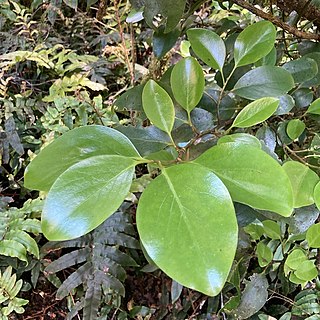
Griselinia littoralis, commonly known as kapuka, New Zealand broadleaf or pāpāuma, is a fast-growing small to medium-sized evergreen tree that is native to New Zealand.

Alectryon excelsus, commonly known as tītoki, is a shiny-leaved tree native to New Zealand. It is in the family Sapindaceae. It lives in coastal and lowland forests throughout most of the North Island and from Banks Peninsula to central Westland in the South Island.

Beilschmiedia tawa, the tawa, is a New Zealand broadleaf tree common in the central parts of the country. Tawa is often the dominant canopy tree species in lowland forests in the North Island and the north east of the South Island, but will also often form the subcanopy in primary forests throughout the country in these areas, beneath podocarps such as kahikatea, matai, miro and rimu. Individual specimens may grow up to 30 metres or more in height with trunks up to 1.2 metres in diameter, and they have smooth dark bark. The Māori word "tawa" is the name for the tree.

Myoporum laetum, commonly known as ngaio or mousehole tree is a plant in the family Scrophulariaceae endemic to New Zealand, including the Chatham Islands. It is a fast growing shrub, readily distinguished from others in the genus by the transparent dots in the leaves which are visible when held to a light.
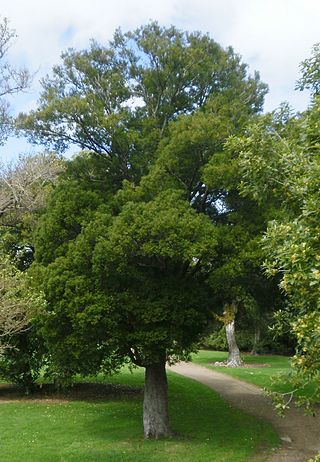
Prumnopitys ferruginea, commonly called miro, is an evergreen coniferous tree which is endemic to New Zealand. Before the genus Prumnopitys was distinguished, it was treated in the related genus Podocarpus as Podocarpus ferrugineus.

Aristotelia serrata, commonly known as wineberry or in the Māori language makomako or just mako, is a small tree in the family Elaeocarpaceae, in the genus Aristotelia, found in the North Island, South Island and Stewart Island of New Zealand.

Vitex lucens, or pūriri, is an evergreen tree endemic to New Zealand.

Griselinia is a genus of seven species of shrubs and trees, with a highly disjunct distribution native to New Zealand and South America. It is a classic example of the Antarctic flora. It is the sole genus in the family Griseliniaceae. In the past it was often placed in Cornaceae but differs from that in many features.

Kunzea ericoides, commonly known as kānuka, kanuka, white tea-tree or burgan, is a tree or shrub in the myrtle family, Myrtaceae and is endemic to New Zealand. It has white or pink flowers similar to those of Leptospermum and from its first formal description in 1832 until 1983 was known as Leptospermum ericoides. The flowers have five petals and up to 25 stamens which are mostly longer than the petals.

Melicytus ramiflorus is a small tree of the family Violaceae endemic to New Zealand.
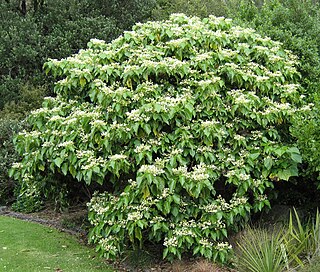
Entelea arborescens or whau is a species of malvaceous tree endemic to New Zealand. E. arborescens is the only species in the genus Entelea. A shrub or small tree to 6 m with large lime-like leaves giving a tropical appearance, whau grows in low forest along the coast of the North Island and the northern tip of the South Island. The dry fruit capsules are very distinctly brown and covered with spines. The common name whau is a Māori word that appears to derive from the common Polynesian word for hibiscus, particularly Hibiscus tiliaceus, which it superficially resembles. Alternate names include 'New Zealand mulberry', 'corkwood' and 'evergreen lime'.

Nothofagus truncata, or hard beech, is a species of tree endemic to New Zealand. Its common name derives from the fact that the timber has a high silica content, making it tough and difficult to saw. Hard beech is a tree up to 30m tall occurring in lowland and lower montane forest from latitude 35°S to 42°30'S, that is, from the north of the North Island southwards to Marlborough and south Westland in the South Island. In Taranaki it forms almost pure stands on the rugged sandstone country there and is partially deciduous, dropping many of its leaves at the end of the winter. N. truncata became known as Fuscospora truncata after 2013 in New Zealand.

Metrosideros fulgens is a forest liana or vine endemic to New Zealand. It occurs in coastal and lowland forest throughout the North Island, on the west coast of the South Island and on the Three Kings Islands north of Cape Reinga. It is one of a number of New Zealand Metrosideros species which live out their lives as vines, unlike the northern rata (M.robusta), which generally begins as a hemi-epiphyte and grows into a huge tree. Scarlet rātā is one of the better-known species of rātā vines, because it flowers in autumn or winter, and is often highly visible on well-lit host trees along forest roads, with vibrant displays of large red flowers that rise above the forest canopy.
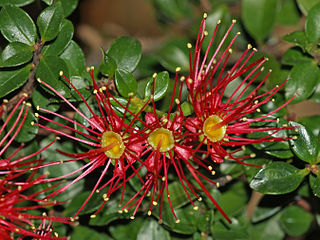
Metrosideros carminea is a forest liane or vine that is endemic to New Zealand. It occurs in coastal and lowland forest from Te Paki in the north of the North Island south to Māhia Peninsula and Taranaki. It is one of a number of New Zealand Metrosideros species which live out their lives as vines, unlike the northern rata (M.robusta), which generally begins as a hemi-epiphyte and grows into a huge tree.

Ixerba brexioides, the sole species in the genus Ixerba, is a bushy tree with thick, narrow, serrated, dark green leaves and panicles of white flowers with a green heart. The fruit is a green capsule that splits open to reveal the black seeds partly covered with a fleshy scarlet aril against the white inside of the fruit. Ixerba is an endemic of the northern half of the North Island of New Zealand. Common names used in New Zealand are tawari for the tree and whakou when in flower. It is assigned to the family Strasburgeriaceae.

Ascarina lucida, commonly known as hutu is a species of small tree in the family Chloranthaceae. It is endemic to New Zealand, being common on the West Coast and Nelson regions of the South Island and more rarely found in the North Island. A typical plant association is within the Westland podocarp/broadleaf forests with common understory associates of Blechnum discolor, Pseudowintera colorata, Pseudopanax colensoi and Coprosma lucida. Most genus members are dioecious, producing unisexual male or female flowers on separate plants. Ascarina lucida, the only member of its genus to occur in New Zealand, is monoecious. It will grow to a height of 6m and can have a 30 cm trunk. The leaves which are in opposite pairs are simple, yellowish green in color, have a raised mid rib and are very similar to Laurelia novae-zelandiae. Their margins have prominent teeth which are dark colored at the tips. Ascarina lucida is now nearly extinct in the Taranaki region but was last reported in Oct 1969 at Mt Taranaki, near Pukeiti by Colin Ogle.

Carpodetus serratus is an evergreen tree with small ovate or round, mottled leaves with a toothy margin, and young twigs grow zig-zag, and fragrant white flowers in 5 cm panicles and later black chewy berries. It is an endemic of New Zealand. Its most common name is putaputāwētā which means many wētā emerge - referring to the nocturnal Orthoptera that live in holes in the trunk of this tree made by Pūriri moth caterpillars. Regional variations on the name also refer to this insect that lives and feeds on it such as kaiwētā, and punawētā. The tree is also sometimes called marbleleaf. It is found in broadleaf forest in both North, South and Stewart Islands. It flowers between November and March, and fruits are ripe from January to February.
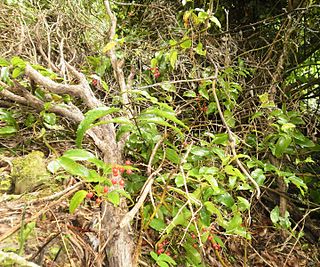
Ripogonum scandens, is a common rainforest vine native to New Zealand. It can also grow in areas of swamp.
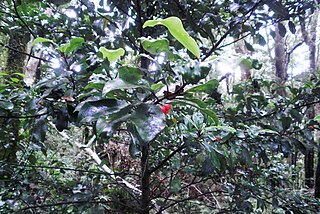
The Pseudowintera axillaris is a shrub like tree, endemic to New Zealand. They are members of the Winterace family and are known for their peppery taste, and glossy green leaves.
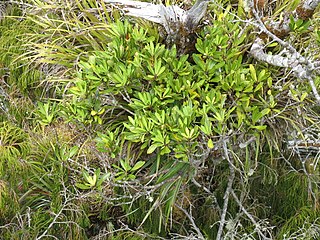
Pittosporum kirkii is a glabrous evergreen perennial shrub that reaches up to 5 metres (16 ft) in height and possesses distinctive coriaceous, fleshy, thick leaves. It is one of four shrubs endemic to New Zealand that frequently displays an epiphytic lifestyle. P. kirkii is commonly epiphytic, perched amongst nest epiphytes in the canopies of emergent or canopy trees in old-growth forest; however, it can be observed occasionally growing on the ground or over rocks. Kirk first observed P. kirkii on Great Barrier Island. It was described by Joseph Dalton Hooker from material collected by Thomas Kirk, possibly from the Thames Goldfields, and published in 1869. The initial brief description titled Pittosporum n. sp.? by Thomas Kirk was published in his paper on Great Barrier Island in 1868. This description along with herbarium specimens were sent to Dr. J. D Hooker at Kew Gardens in 1868, and he collaborated to name it after T. Kirk, by giving it the specific epithet kirkii within the publication that was otherwise written by Kirk.





















